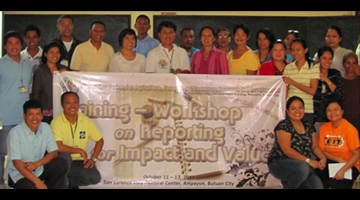 The annual report (AR) of the consortium is the major indicator for the consortium’s performance for the year. Thus motivated, members of the Caraga Consortium for Agriculture and Resources Research and Development (CCARRD) braved Typhoon Ramon for the training, “Reporting for impact and value” held on October 11─13 at the San Lorenzo Ruiz Retreat Center in Butuan City.
The annual report (AR) of the consortium is the major indicator for the consortium’s performance for the year. Thus motivated, members of the Caraga Consortium for Agriculture and Resources Research and Development (CCARRD) braved Typhoon Ramon for the training, “Reporting for impact and value” held on October 11─13 at the San Lorenzo Ruiz Retreat Center in Butuan City.
Together with the Philippine Council for Agriculture, Aquatic and Natural Resources Research and Development’s (PCAARRD) Institution Development Division, CCARRD officials led by Consortium Director Rowena Varela planned the training to enhance the members’ capabilities to develop their consortium (and even agency) annual report.
Through the training, the participants (1) became familiar with the PCAARRD format for theAR; (2) revisited the basics of AR preparation; (3) through consensus, developed the consortium AR plan [writing and development] and the timeline and milestones for the preparation of the report; and (4) improved or gained skills in effective writing.
Representing PCAARRD and serving as resource persons for the training were Dr. Marcelino U. Siladan and this writer. Dr. Siladan represents PCAARRD’s Forestry and Environment Research Division and is a member of CCARRD’s Regional Technical Group. This writer represents the Council’s Applied Communication Division.
Over three days, participants studied various aspects of writing an AR and tried their hand at drafting a template to highlight the consortium’s accomplishments. Dr. Siladan discussed the prescribed format of the AR and its importance in the initial evaluation for the Ugnay Award. This became the jumping point for this writer on how the consortium fared in 2010 based on its AR.
The participants then brainstormed on the questions they would be answering for their section of the AR: (1) Research and Development Management, (2) Research and Development Activities, (3) Capability Building and Governance, and (4) Policy Advocacy for S&T Development. They then outlined answers to the questions they posed and determined the data they would need to present a compelling picture of consortium accomplishments.
Each group then presented its outputs for discussion and critiquing. Improved outputs became the basis for the next workshop at which the participants now developed a sample page or report. The resource persons evaluated the proposed report contents and provided examples of how the report could be improved further.
This writer concluded the training with a discussion on the “science” of AR writing and a proposed AR plan for the consortium’s consideration. Dr. Varela thanked everyone for participating and PCAARRD for its support in the conduct of the training. She hoped that the attendees would use their new-found skills in improving their respective agency’s ARs as well as contribute to making the CCARRD AR more substantive.
For their part, the participants wanted more training in the same vein. Enthusing on the importance of developing an effective report, they were unanimous in hailing the benefits of the training and looked forward to composing CCARRD’s report for 2011.
